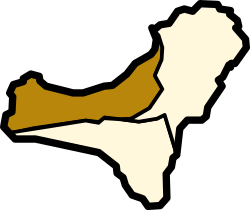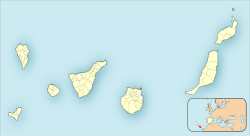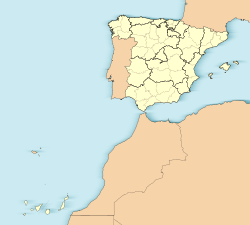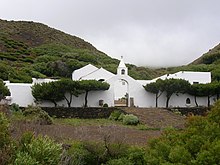
The Canary Islands, also known informally as the Canaries, are a Spanish autonomous community and archipelago in Macaronesia in the Atlantic Ocean. At their closest point to the African mainland, they are 100 kilometres west of Morocco and the Western Sahara. They are the southernmost of the autonomous communities of Spain. The islands have a population of 2.2 million people and are the most populous special territory of the European Union.
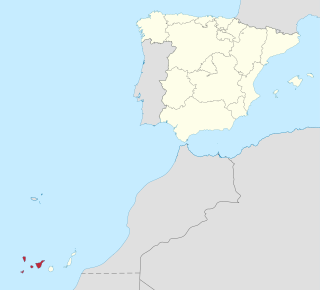
Province of Santa Cruz de Tenerife, also Province of Santa Cruz, is a province of Spain, consisting of the western part of the autonomous community of the Canary Islands. It consists of about half of the Atlantic archipelago: the islands of Tenerife, La Gomera, El Hierro, and La Palma. It occupies an area of 3,381 km2 (1,305 sq mi). It also includes a series of adjacent roques.

Tenerife is the largest and most populous island of the Canary Islands. It is home to 43% of the total population of the archipelago. With a land area of 2,034 square kilometres (785 sq mi) and a population of 978,100 inhabitants as of January 2022, it is also the most populous island of Spain and of Macaronesia.

Santa Cruz de Tenerife, commonly abbreviated as Santa Cruz, is a city, the capital of the island of Tenerife, Province of Santa Cruz de Tenerife, and one of the capitals of the Canary Islands, along with Las Palmas. Santa Cruz has a population of 206,593 (2013) within its administrative limits. The urban zone of Santa Cruz extends beyond the city limits with a population of 507,306 and 538,000 within urban area. It is the second largest city in the Canary Islands and the main city on the island of Tenerife, with nearly half of the island's population living in or around it.

El Hierro, nicknamed Isla del Meridiano, is the second-smallest and farthest-south and -west of the Canary Islands, in the Atlantic Ocean off the coast of Africa, with a population of 10,968 (2019). Its capital is Valverde. At 268.51 square kilometres (103.67 sq mi), it is the second-smallest of the eight main islands of the Canaries.
Los Realejos is a town and a municipality in the northern part of the island of Tenerife, which is the biggest town in the Canary Islands. It is part of the province of Santa Cruz de Tenerife, Spain. The town is located 2 km (1.2 mi) from the north coast, 5 km (3.1 mi) southwest of Puerto de la Cruz, 6 km (3.7 mi) west of La Orotava, and 34 km (21 mi) southwest of the island's capital Santa Cruz de Tenerife. The inhabitants are known in Spanish as realejeros.
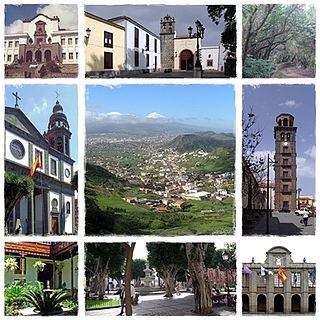
San Cristóbal de La Laguna is a city and municipality in the northern part of the island of Tenerife in the Province of Santa Cruz de Tenerife, on the Canary Islands, Spain. The former capital of the Canary Islands, the city is the third-most populous city of the archipelago and the second-most populous city of the island. La Laguna's historical center was declared a World Heritage Site by UNESCO in 1999. La Laguna is situated alongside the city of Santa Cruz de Tenerife; thus, the two cities and municipalities form a single large urban center. Its economy is business-oriented while agriculture dominates the northeastern portion of the city. The urban area dominates the central and the southern parts.

Valverde is a municipality in the Canary Islands in the province of Santa Cruz de Tenerife. It is located on the north-east part of El Hierro. The town of the same name serves as the island's official capital. It is both the smallest Canarian capital and the only one not located by the sea. The town's airport and seaport are both several kilometres away on the island's east coast.
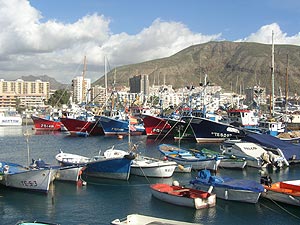
Los Cristianos is a town in Spain with a population of 21,235 (2017), situated on the south coast of the Canary Island of Tenerife. Located in the municipality of Arona between the cone of the mountain Chayofita and the greater mountain Guaza. The town centre is around the Los Cristianos bay, but is rapidly expanding inland with modern development. The town is a popular tourist resort and includes a ferry port and two beaches.

The Diocese of San Cristóbal de La Laguna, also called Diocese of Tenerife or Diocese Nivariense, is a diocese located in the city of San Cristóbal de La Laguna in the Canary Islands and a suffragan in the ecclesiastical province of the Archdiocese of Sevilla in Spain. The diocese includes the islands of Tenerife, La Palma, La Gomera and El Hierro, in the province of Santa Cruz de Tenerife. The bishop of this diocese is Bernardo Álvarez Afonso.

"Bajada" is the shortened version of the Fiestas de la Bajada which is a festival which takes place in several places in the Canary Islands. Bajada is Spanish for "bringing down", and means the bringing of a patron saint's statue from its normal place in a chapel to be celebrated by the people.

The Port of Santa Cruz de Tenerife in Santa Cruz de Tenerife, is used by fishing boats, commercial and passenger ships, and sports. Located on the Atlantic Ocean, it is managed by the Port Authority of Santa Cruz de Tenerife, who also manage all commercial and leisure ports of the Province of Santa Cruz de Tenerife. Next to this port is the famous building of the Auditorio de Tenerife.

The Punta Orchilla Lighthouse is an active lighthouse on the Canary island of El Hierro in the municipality of El Pinar. The need for a lighthouse on the island was highlighted in the second maritime lighting plan for the Canaries, and it first became operational in 1933.

Pico de Malpaso is the highest point on the island of El Hierro in the Canary Islands, Spain.
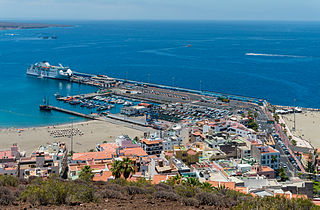
The Port of Los Cristianos is a port of the Atlantic Ocean located in the town of Los Cristianos, in the municipality of Arona on the island of Tenerife. It is administered by the Port Authority of Santa Cruz de Tenerife. It is the port with the highest passenger and vehicle traffic in the Canary Islands, in 2007 it had 1,829,579 passengers, and 238,836 vehicles.
As in the rest of Spain, the majority religion in the Canary Islands is the Catholic Church. The Catholic religion has been the majority since the Conquest of the Canary Islands in the fifteenth century. This religion would largely replace the Canarian aboriginal religion through the prohibition of the latter and syncretism. According to a survey conducted in 2019, Canary Islands is the fifth autonomous community in Spain with the highest percentage of people who declare themselves to be Catholics after the Region of Murcia, Extremadura, Galicia, Aragon, and Castile and León. 76.7% of the population is Catholic.

Paradores de Turismo de España S.M.E.S.A., branded as Paradores, is a Spanish state-owned chain of luxury hotels that are usually located in historic buildings or in nature areas with a special appeal. Its very first parador was inaugurated on 9 October 1928 in Navarredonda de Gredos (Ávila). As of 2022, it operates 97 paradores in Spain and one in Portugal, with 5,988 rooms in total. Every parador has its own restaurant offering the regional gastronomy of its area.

